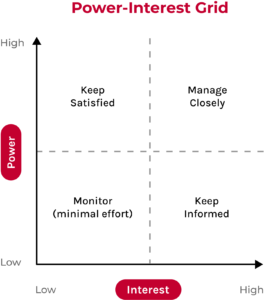At The Clearing, we believe that strategic communication is always important, but perhaps at no other time does it feel as critical as during a leadership transition. Understanding what’s at stake, so that a leader can make intentional decisions about their communications plan, can mean the difference between a smooth transition built on trust and one fraught with rumors, stress, loss of productivity, or worse, the loss of clients or business. For tips and insights on how to make communications work for you rather than against you during a transition, here is Senior Principal Joy Langley.
What’s in it for Me?
No matter the circumstances behind a change in leadership – merger, retirement, or unexpected transition – staff want to immediately know how it will affect them. “Will I be okay?” is their focus – and if the strategic communications around that singular point aren’t managed or prioritized, someone else will create the narrative. Oftentimes, in a vacuum of information, narratives will be created by your organization’s most loyal, hardworking employees, with a net negative effect on reputation, workforce, buy-in, productivity, and bottom line.
Consider what happens when a celebrity scandal breaks and their PR team’s immediate response is something along the lines of, “Please respect our privacy at this time.” Where does your assumption about the scandal go? Yet if the allegations are false, most individuals will come out with a strong statement that declares they’ll fight it, to preserve their reputation.
How does this relate to a leadership transition? It’s simple: When you own the message, you take back the power.
This is the essence of Feedback as Caring PRIME – delivering the right message to the right people in the right way, for the right reason at the right time. Those same fundamentals can apply to strategic communication during a transition. Again, it does not matter if leadership is changing because someone is retiring or they’re moving on to a new opportunity; you can frame the transition as an opportunity by turning the lens internally first, focusing on how your employees are going to feel or be directly impacted by the transition.
To begin, create a timeline to help you through the transitionary time, and think about how you’ll open new lines of communication with the new leadership. The extension of employee assistance programs (EAPs) is another important tactic, particularly if the transition is unexpected or involves an unpredictable life event, such as an unexpected death due to tragedy or illness. Damage often comes in the space created by the vacuum of silence, so act boldly and communicate clearly and strategically during any leadership transition.

Shared Awareness of What’s Happening
At the Clearing, we have a power interest grid that can help guide your communications with employees and strategically help alleviate fears. Specifically, messaging is contingent on what matters to whom and when. Additionally, those most interested and those most affected by the change will require different, more immediate messaging than those less interested and those less affected by the change. For example, low-power/high-interest employees will likely feel more anxious than high-power/high interest, which means they would benefit from regular, clear, and concise communications delivered frequently – even weekly – even if the update is there is no update.
As you determine how to communicate updates across the spectrum of stakeholders, remember to communicate with empathy, because it’s easy for people to feel powerless during a leadership transition. Someone who has worked with a CEO for 19 of their 20 years with an organization is going to feel a great deal of ambiguity and experience scarcity in a very real way.
To stay engaged between your communications be sure also to provide an accessible space, such as an optimized micro-website (e.g. an intranet), that employees can access at any time. Commit to updating it on a set schedule, whether that’s every three hours or once a week. Your level of effort will be proportionate to the nature of the transition; if it’s a very large company with extraordinary business impacts, you may be updating it every six to 12 hours via a dedicated, trusted, highly organized member of your team.
Maintaining Business as Usual
What do your clients, vendors, or partners need to know? Your delivery teams will be key for identifying the practical business risks, the mitigation strategy, and how you’ll identify and revise your approach if needed. Delivery teams will need to evaluate whether strategic communications should vary by party and should create a plan based on the significance of that risk by party.
Just as you do for internal stakeholders, you should do the same for external stakeholders. You may have very large clients who aren’t concerned with the transition and are very confident in the level of delivery. For them, provide access to an informational microsite along with an overview of any immediate implications via a 30-60-90-day plan, for example. Give them a point of contact for someone who will always be able to answer their questions as they arise, and share with them the qualities of the interim leader. For smaller, more engaged clients, your communications will likely need to be more personalized and frequent.
Consider too how you will introduce the new leader. If the interim leader is from within the organization, frame the transition as an opportunity for a person who knows the company, is a workhorse, and has consistently delivered. Share your excitement at the opportunity for them to showcase their skills. If the interim leader is from outside the company or is a professional interim leader, focus on their skillsets and proven track records. Make it clear they’re personally meeting with your board and C-suite. The more information you share, the less scary it can feel for stakeholders, shareholders, employees, and clients. And remember: If you aren’t talking about it, someone else will. Own it and show confidence in your plan – that’s mission-critical.
What You Can Do to Be Prepared
As a final piece of advice, it’s never too early to prepare for a leadership transition. Having succession plans in place and a clear plan to communicate them should the need arise is the best preventative measure for ensuring a leadership transition doesn’t go off the rails. Doing so will help you stay ahead of and own the narrative instead of being caught on the back foot and forced to improvise.
If your organization needs help doing that preventative work, our Leadership and Organizational Strategy experts have the experience you need to build a bulletproof plan. As we discussed, it’s never too early to plan, so reach out anytime.






 The Clearing’s Employee Experience
Improvement model, adapted from Itam
& Ghosh, 2020, focuses on three objectives:
The Clearing’s Employee Experience
Improvement model, adapted from Itam
& Ghosh, 2020, focuses on three objectives: 














